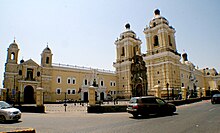Jirón Lampa
This article relies largely or entirely on a single source. (December 2023) |
 Basilica and Convent of San Francisco and Jirón Áncash, seen from Jr. Lampa | |
| Part of | Damero de Pizarro |
|---|---|
| Namesake | Lampa, Peru |
| From | Jirón Amazonas |
| Major junctions | Jirón Junín, Jirón Cuzco, La Colmena, |
| To | Paseo de la República |
| Construction | |
| Completion | 1535 |
Jirón Lampa is a major street in the Damero de Pizarro, located in the historic centre of Lima, Peru. The street starts at its intersection with the Jirón de la Unión and continues until it reaches the Paseo de la República.
History
[edit]The road that today constitutes the street was laid by Francisco Pizarro when he founded the city of Lima on January 18, 1535. In 1862, when a new urban nomenclature was adopted, the road was named jirón Lampa. Prior to this renaming, each block (cuadra) had a unique name:
- Block 1: Soledad, after a chapel of the same name.[1]
- Block 2: Santo Toribio, after the school of the same name.[2][3]
- Block 3: Santa Apolonia, after the chapel of the same name.[4]
- Block 4: Carrera, after a bakery owned by Pedro Carrera.[5]
- Block 5: Picantería, possibly after a food establishment of the same type.[6]
- Block 6: San Antonio, after the counts of San Antonio de Vistaalegre, who lived there.[7]
- Block 7: Pileta de la Trinidad, after the fountain of the same name.[8]
- Block 8: Fano, after a neighbour not conclusively identified. One of the residents here was Dr. Manuel Atanasio Fuentes, whose home was the place where the members of the wartime government of Francisco García Calderón met.[9]
- Block 9: Pobres, after its early inhabitants: people of low income.[10]
- Block 10: Cádices, after the family of Miguel de Cádiz, who lived there.[11]
- Block 11: Sauce, possibly after a willow located there.[12]
On July 28, 2000,[13][14] amid the protests known as the Four Quarters March, a fire began inside the building of the Bank of the Nation, located in the intersection with La Colmena Avenue. Despite claims by Minister of the Interior Walter Chacón of the opposite, the fire was caused by an explosion on the building's third floor which caused the structural integrity of the building's lower floors to be compromised, causing them to collapse and worsen the gravity of the situation.[15] As a result, 6 security guards were killed in fire.[16]
See also
[edit]References
[edit]- ^ Bromley Seminario 2019, p. 403.
- ^ Bromley Seminario 2019, p. 399–400.
- ^ Planas, Enrique. "Las casonas del Centro de Lima". El Comercio.
- ^ Bromley Seminario 2019, p. 393.
- ^ Bromley Seminario 2019, p. 225–228.
- ^ Bromley Seminario 2019, p. 345–346.
- ^ Bromley Seminario 2019, p. 380.
- ^ Bromley Seminario 2019, p. 347–348.
- ^ Bromley Seminario 2019, p. 263–264.
- ^ Bromley Seminario 2019, p. 353.
- ^ Bromley Seminario 2019, p. 217–218.
- ^ Bromley Seminario 2019, p. 400.
- ^ "El cuerpo de bomberos voluntarios del Perú en la historia". Andina. 2018-12-05.
- ^ "Estos fueron los incendios más devastadores en Lima en el siglo XXI". RPP Noticias. 2016-11-16.
- ^ "Sí, hubo explosión: Ocurrió en el tercer piso y provocó caida parcial del edificio del Banco de la Nación". La República. 2000-08-13. p. 3.
La explosión en el tercer piso habría provocado la destrucción de las paredes, el rompimiento de las columnas y el desmoronamiento de los techos. El incendio no pudo causar tal desastre.
- ^ "Sentencian a 10 años de prisión efectiva a Montesinos por muerte de vigilantes del Banco de la Nación". Andina. 2009-08-27.
Bibliography
[edit]- Bromley Seminario, Juan (2019). Las viejas calles de Lima (PDF) (in Spanish). Lima: Metropolitan Municipality of Lima.
